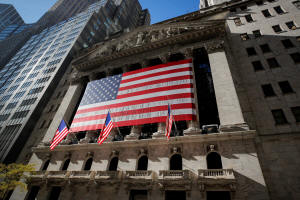Wall Street Week Ahead: Stock investors cast wary eye on yield rally
 Send a link to a friend
Send a link to a friend
 [November 14, 2020]
By David Randall [November 14, 2020]
By David Randall
NEW YORK (Reuters) - As Treasury yields
rally to multi-month highs, some investors are gauging how a more
sustained rise could impact equity markets.
Yields on the 10-year Treasury, which move inversely to bond prices,
rose to a seven-month high of 0.97% in the past week on hopes that
breakthroughs in the search for a COVID-19 vaccine would eventually
translate to a boost in economic growth.
That's still low, by historical standards: yields are a full point below
their levels at the start of January and below their 5-year average of
2.05%, according to Refinitiv data. The Federal Reserve has pledged to
keep interest rates near historic lows for years to come in its bid to
support growth, and past rallies in yields have faded in recent years.
Expectations that a vaccine against the coronavirus could fuel a broad
economic revival, however, have also spurred bets that yields could
continue edging higher. That could potentially weaken the case for
holding shares that have become expensive during the S&P 500ís 58% rally
from its lows of the year.

"If growth turns out better than anybody thought, the bad news is that
the Fed might not have as much control over the extended curve," said
Ralph Segall, chief investment officer at firm Segall, Bryant & Hamill.
"That would probably cause stocks to pause."
Analysts at Goldman Sachs this week forecast Treasury yields will hit
1.3% by the end of next year and 1.7% by 2022. They also raised their
forecast for the S&P to 4,100 by the middle of next year, a roughly 16%
gain from recent levels.
For now, analysts believe yields have some way to go before they become
an obstacle to further stock gains.
The benchmark S&P 500 has climbed by an average of 1.37% a month during
rising rate environments when the yield 10-year Treasury remained at 3%
or below, according to Sam Stovall, chief investment strategist at
research firm CFRA.
The S&P 500 gained an average of 0.53% a month with yields above 3%, he
said.
How quickly yields rise also matters, said Stephanie Link, chief
investment strategist at Hightower Advisors.
A gradual increase as the economy improves allows companies time to roll
over or refinance debt, while a sharp jump higher is more likely to
shock the market, she said.
[to top of second column]
|

The U.S. flag covers the front facade of the New York Stock Exchange
(NYSE) in New York City, New York, U.S., November 9, 2020.
REUTERS/Brendan McDermid

Technology stocks, which have led the market higher this year, could
be the first sector to feel the weight of higher rates, said Segall.
Rates moving above 1.5% "would suggest that growth was better than
anybody thought" and pull investors into more cyclical areas of the
market while potentially dimming the allure of tech-related names,
he said.
Investors next week will have their eyes on earnings reports and
forecasts from U.S. retailers to gauge how consumer demand is faring
in the worst public health crisis in decades. The number of
Americans filing new claims for unemployment benefits fell to a
seven-month low last week, while consumer prices remained unchanged.
At the same time, Treasury yields are far from eclipsing the average
2.07% dividend yield of S&P 500 stocks.
Should yields grind higher, "a lot of investors would still see
dividend payers as attractive because their yields are so much
higher" than those offered by bonds while also offering capital
gains, said Bill McMahon, chief investment officer for active
strategies at Charles Schwab Investment Management.
Plenty of investors believe rates are unlikely to rise much further.

An upward trend in rates will not likely be sustained until there
are signs that the pandemic is being contained, either through
falling infection rates or the widespread availability of vaccines,
said Margie Patel, senior portfolio manager at Wells Fargo Asset
Management.
Until case counts fall, 10-year Treasuries are likely to remain in a
trading range below 1.1%, she said.
(Reporting by David Randall; Editing by Dan Grebler)
[© 2020 Thomson Reuters. All rights
reserved.] Copyright 2020 Reuters. All rights reserved. This material may not be published,
broadcast, rewritten or redistributed.
Thompson Reuters is solely responsible for this content. |